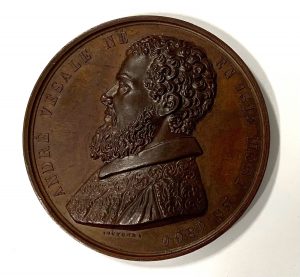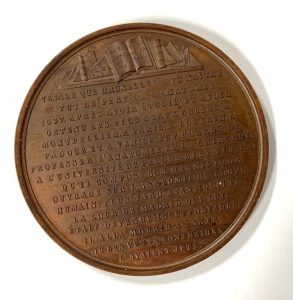 Have you ever looked at the HSLS collection of medical and scientific medals? Numismatic materials, including medals, coins, and tokens are not typical resources in a medical library. The first medals were produced in Italy in the 15th century. They were based on Roman coins, cast in bronze, and usually had portraits of emperors. The earliest medal in our collection is the Caracalla Medal. It was struck in Venice, Italy in 1466. Over the centuries, the techniques changed and new metals were used in production with later medals being cast or struck in silver or gold. By the 19th century, the medallic art became a recognizable new art form taught as a separate subject in art schools.
Have you ever looked at the HSLS collection of medical and scientific medals? Numismatic materials, including medals, coins, and tokens are not typical resources in a medical library. The first medals were produced in Italy in the 15th century. They were based on Roman coins, cast in bronze, and usually had portraits of emperors. The earliest medal in our collection is the Caracalla Medal. It was struck in Venice, Italy in 1466. Over the centuries, the techniques changed and new metals were used in production with later medals being cast or struck in silver or gold. By the 19th century, the medallic art became a recognizable new art form taught as a separate subject in art schools.  Medals, unlike coins, or at times tokens, are not monetary instruments. They are frequently used to commemorate people, events, or things. As a perfect medium, and due to their permanence, they pass along information about past events and man’s achievements to future generations.
Medals, unlike coins, or at times tokens, are not monetary instruments. They are frequently used to commemorate people, events, or things. As a perfect medium, and due to their permanence, they pass along information about past events and man’s achievements to future generations.
The Andreas Vesalius medal, slightly bigger than an American silver dollar, is a typical commemorative medal. The obverse has a portrait of the famous anatomist surrounded by his name and life dates. The small image of books on the reverse side commemorates his greatest work, De humani corporis fabrica, published in Basel in 1543. The inscription, loosely translated from the French, summarizes his life achievements:
Vesalius, who was born in Brussels,
was the father of anatomy.
In 1537, after finishing studies and achieving
the greatest success in
Montpellier, in Paris, in Louvain, in
Padua and in Venice, [he] was charged
to teach anatomy and surgery
at the University of Padua, where
he composed his magnificent
book on the anatomy of the human
body. Later, after leaving
the court in Madrid, which
had become unbearable to him,
he went to die in Zante
where the contrary winds
had thrown him.
Could you imagine a better tribute to Vesalius, which would be more succinct and yet fit in your palm?
This medal and 13 others recently uncovered in the file of a retired librarian are currently on display in the Falk Library lobby.
Please send inquiries to the History of Medicine.
~Gosia Fort